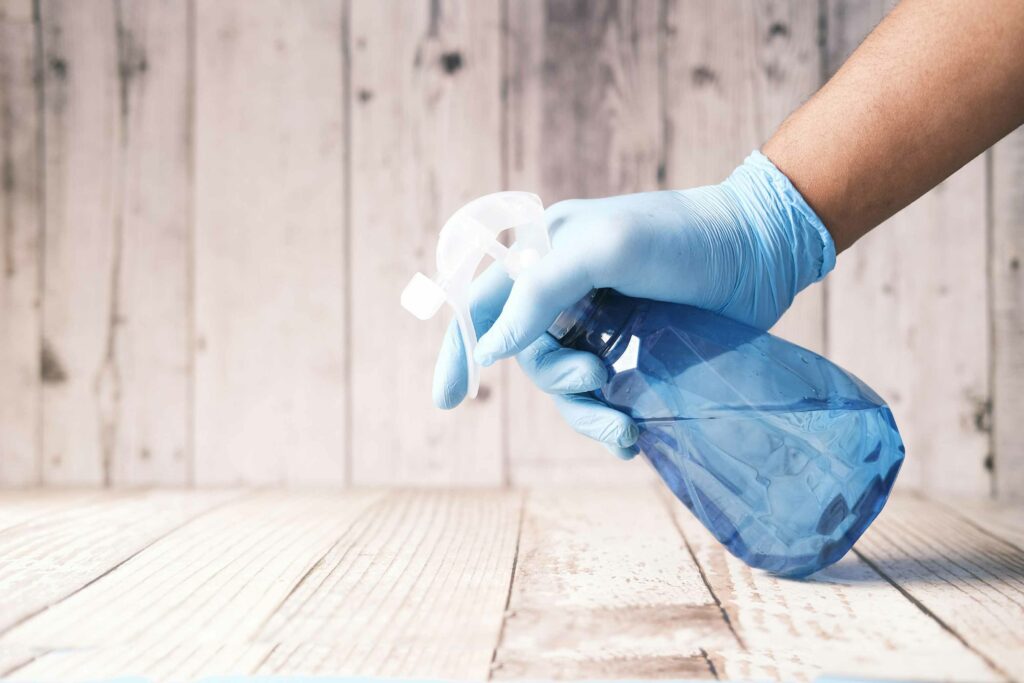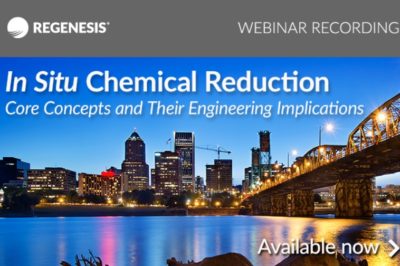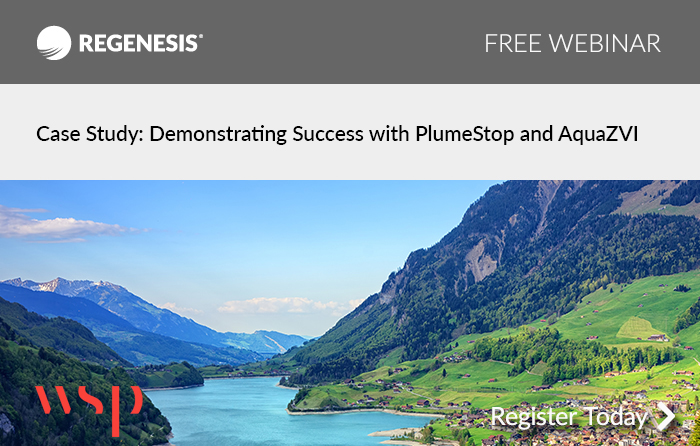La puissance de la déchloration réductrice améliorée pour le traitement in situ de polluants chlorés.
Première diffusion: 29.11.2019
Intervenants: Aurélien Triger and Kris Maerten (REGENESIS)
Ils ont expliqué comment les contaminants chlorés se comportent dans le sous-sol, y compris leur distribution, ainsi que les problématiques liées à la rétrodiffusion. Puis ils ont détaillé la déchloration réductrice améliorée à l’aide de substrats injectables, notamment:
- Explication du processus de déchloration réductrice
- Types de substrats utilisés
- Le processus de dépollution
- Un accent sur l’aspect chantier et les méthodes d’injection
- Les résultats attendus et durées prévues
La présentation est illustrée d’exemples de résultats terrains à échelle réelle, obtenus en France et en Europe.
Les tendances actuelles et les futures possibilités de la technologie de donneurs d’électrons seront sont discutées, y compris la combinaison de l’ERD avec d’autres technologies telles que l’ISCR, la bioaugmentation et la sorption.
Regarder l’enregistrement du webinaire
Due nuove tecnologie di bonifica per il trattamento di elevate concentrazioni di contaminanti nelle acqua di falda
First broadcast: March 21, 2019
Speakers: Marcello Carboni, Regional Manager Europe
Questo webinar introduce due nuove tecnologie REGENESIS: il ferro zero-valente colloidale a microscala e solfurato, e il carbone attivo per il trattamento di idrocarburi mediante un duplice processo. Entrambe le tecnologie sono in grado di gestire elevati livelli di contaminazione nelle acque di falda.
Si discute innanzitutto del S-MicroZVI™ , il nostro nuovo e innovativo reagente ISCR (In Situ Chemical Reduction) che combina:
- particelle colloidali di ZVI (cZVI) per un’elevata dispersibilità
- rivestimento mediante solfurazione delle particelle per incrementare l’attivazione e aumentare la longevità
- sospensione in glicerolo per ridurre la passivazione e fornire un processo di biorisanamento potenziato da ISCR
Questo nuovo entusiasmante sviluppo nella tecnologia ferro zerovalente è particolarmente efficace per promuovere la rapida degradazione di solventi clorurati, pesticidi, composti alogenati, energetici e altri composti organici volatili tossici (CVOC).
Si discute successivamente del PetroFix®, un composto appositamente formulato a base di carbone attivo e accettori di elettroni. PetroFix è stato ingegnerizzato per il trattamento di sversamenti e plumes di idrocarburi petroliferi. Petrofix riduce rapidamente il rischio correlato alla presenza dei contaminanti residui adsorbendo gli idrocarburi e stimolando la loro attenuazione naturale attraverso la biodegradazione sintrofica. Applicato mediante iniezioni o direttamente all’interno degli scavi, Petrofix può essere utilizzato:
- come parte di una strategia attiva di bonifica
- durante una fuoriuscita di oli per prevenire la formazione di un plume o di odori
- come misura preventiva all’interno di parchi serbatoi e attorno a linee interrate, per mitigare future perdite e fuoriuscite
- su siti orfani, in cui non è possibile utilizzare sistemi attivi di bonifica
Riteniamo che questo webinar possa essere utile per gli Enti di controllo, i consulenti ambientali e le società esecutrici degli interventi di bonifica e per tutti coloro che sono interessati ad aumentare le proprie opzioni per il trattamento economicamente sostenibile di siti contaminati da solventi clorurati e idrocarburi.
Guarda la registrazione webinar
In Situ Chemical Reduction (ISCR): The Core Concepts and Their Engineering Implications
First broadcast: September 19, 2018
Speakers: Paul Tratnyek, PhD Professor, Oregon Health & Science University (OHSU)
In this webinar we are pleased to have a special guest presentation by Paul Tratnyek, PhD, Professor in the Division of Environmental and Biomolecular Systems (EBS) and Institute of Environmental Health (IEH), at the Oregon Health & Science University (OHSU). In this presentation he discusses in situ chemical reduction (ISCR), specifically with regard to its core concepts and their engineering implications. Recent groundwater remediation studies demonstrating that there can be an abiotic component to natural attenuation, together with the proliferation of remediation technologies like zero-valent iron, has led to the emergence of a general class of groundwater treatment processes known as “in situchemical reduction” (ISCR). As the field of ISCR matures, it is developing “core concepts” that link fundamental understanding of the controlling processes to technology performance in the field.
This webinar features discussion of:
- Exploration of several core conceptual issues related to ISCR
- How oxidation-reduction potential (ORP) is related to dechlorination rates
- What controls the amount of intermediate “stall” dechlorination products like dichloroethene and vinyl chloride
View the recording of this free webinar
About the presenter:
Paul Tratnyek, PhD
Professor, Oregon Health & Science University (OHSU)
Dr. Paul Tratnyek is Professor in the Division of Environmental and Biomolecular Systems (EBS) and Institute of Environmental Health (IEH), at the Oregon Health & Science University (OHSU). He received his PhD in Applied Chemistry from the Colorado School of Mines (CSM) in 1987; served as a National Research Council Postdoctoral Fellow at the U.S. Environmental Protection Agency Laboratory in Athens, GA (ERD-Athens) during 1988; and as a Research Associate at the Swiss Federal Institute for Water Resources and Water Pollution Control (EAWAG) from 1989 to 1991.
Dr. Tratnyek’s research concerns the physico-chemical processes that control the fate and effects of environmental substances, including minerals, metals (for remediation), organics (as contaminants), and nanoparticles (for remediation, as contaminants, and in biomedical applications). Dr. Tratnyek is best known for his work on the degradation of groundwater contaminants with zero-valent metals, but his interests extend to all aspects of contaminant reduction and oxidation (redox) in all aquatic media. Some of his recent work emphasizes the fate/remediation of emerging contaminants (e.g., nanoparticles and 1,2,3-trichloropropane) and next generation energetic compounds (e.g., DNAN).
Ottimizzazione degli interventi di bonifica in situ della falda utilizzando Ferro Zero Valente colloidale
First broadcast: July 17, 2018
Speakers: Marcello Carboni, Mediterranean District Manager
Ing. Marcello Carboni, District Manager di REGENESIS, presenterà un webinar in cui discuterà i vantaggi dell’utilizzo del ferro zero-valente (ZVI) quale potente strumento per il trattamento di terreni ed acque di falda contaminati da solventi clorurati, pesticidi e altre sostanze tossiche. Il successo degli interventi di bonifica in situ risiede nell’utilizzo di ammendanti che possono offrire una perfetta combinazione di reattività, persistenza e capacità di distribuzione uniforme. Il webinar discuterà come:
- il ZVI colloidale può fornire superfici specifiche elevate con cinetiche di reazione potenziate e allo stesso tempo promuovere percorsi di reazione con i solventi clorurati che possono bypassare la formazione di sottoprodotti tossici.
- il ZVI colloidale consente di ottenere una sospensione acquosa stabile di particelle di piccole dimensioni e può penetrare e attraversare il volume dei pori interconnessi di matrici sabbiose o similari. Rispetto ai prodotti ZVI di dimensioni al di sotto del micron, come il ferro zero-valente nanocristallino (NZVI), le particelle di 2 micrometri persistono per tempi maggiori.
- le particelle colloidali di ZVI sono compatibili e possono essere co-applicate con altri ammendanti, tra cui le sospensioni di carbone colloidale e la maggior parte dei substrati organici donatori di idrogeno.
- ricerche recenti suggeriscono che il ferro solfurato può promuovere una reattività accelerata con eteni ed etani clorurati.
Per registrarti a questo webinar gratuito, compila il form.
Cost-effective Approaches using Colloidal Zero Valent Iron for In Situ Groundwater Remediation
First broadcast: June 19, 2018
Speakers: John Freim, Ph.D., REGENESIS Director of Material Science
Recording Available| In this webinar we are pleased to have a special presentation from John Freim, Ph.D., REGENESIS Director of Materials Science. In his presentation, Dr. Freim discusses the benefits of using zero valent iron (ZVI) as a powerful remediation amendment that can decontaminate soil and groundwater containing chlorinated hydrocarbons, pesticides, and other toxic substances. Successful in situ remediation is predicated on using amendments offering a perfect combination of reactivity, the ability to distribute uniformly, and persistence.
The webinar addresses how:
- Colloidal ZVI provides high surface areas with enhanced reaction kinetics while also promoting reaction pathways with chlorinated hydrocarbons that can bypass the formation of toxic daughter products.
- Colloidal ZVI promotes stable aqueous suspensions with small particles and can fit within and pass through interconnected pore volume of sandy soils and similar environments. Compared to sub-micrometer ZVI products such as nanocrystalline zero valent iron (NZVI), 2 micrometer particles persist for longer timeframes.
- Colloidal ZVI particles are compatible with and can be co-applied with other amendments including colloidal carbon suspensions and most organic hydrogen donors.
- Recent research suggests that sulfidated iron can promote accelerated reactivity with chlorinated ethenes and ethanes.
View webinar recording
Case study: Demonstrating success with PlumeStop and colloidal ZVI – with Matt Burns of WSP
Recording Available| We are pleased to have guest speaker Matt Burns, Senior Fellow at WSP present this live, international webinar. He will present PlumeStop® and colloidal ZVI (cZVI) treatment case studies and practical analytical strategies used to demonstrate destructive treatment.
Stimulating biodegradation of chlorinated VOCs on activated carbon and direct abiotic treatment of using reduced metals such as ZVI are not new to the remediation industry and have proven to be highly effective when direct contact is made. However, the colloidal solid composition of these materials severely limits efficient in situ application at most sites.
The steric stabilization chemistry behind the Regenesis products PlumeStop and cZVI eases delivery challenges and dramatically widens the applicability window of these amendments to include most sites where in situ remediation is contemplated. These transformational amendments bring a unique set of regulatory and performance monitoring challenges when discerning desirable destructive processes from often unacceptable non-destructive mechanisms.
About the Presenter:
About the Presenter:
Matthew Burns, Technical Fellow | U.S. Contaminated Land National Service Line Director, WSP
Matt is a Technical Fellow and the U.S. contaminated land national service line director for WSP with more than 25 years of professional chemistry and engineering experience. He is based in Boston, Massachusetts and is responsible for the financial and technical depth and breadth of the contaminated land (site investigation and remediation) service line. Matt brings chemical and microbial process expertise to assist local WSP teams with challenging investigation and remediation projects in the U.S. and across the globe.
View webinar recording
How to Select and Use Molecular Biological Tools (MBTs)
First broadcast: July 18, 2018
Speakers: Dora Taggart President, Microbial Insights, Inc.
In this webinar we are pleased to have as a special guest speaker Dora Taggart, President of Microbial Insights, Inc. (MI). Her presentation will include a series of case studies that demonstrate how molecular biological tools (MBTs) such as QuantArray® and compound specific isotope analysis (CSIA) provided actionable data that directly impacted site management decisions.
View the recording of this free webinar
Case study: Demonstrating success with PlumeStop and colloidal ZVI – with Matt Burns of WSP
First broadcast: May 30, 2018
Speakers: Matthew Burns, Technical Fellow WSP
Recording Available| We are pleased to have guest speaker Matt Burns, Senior Fellow at WSP present this live, international webinar. He will present PlumeStop® and colloidal ZVI (cZVI) treatment case studies and practical analytical strategies used to demonstrate destructive treatment.
Stimulating biodegradation of chlorinated VOCs on activated carbon and direct abiotic treatment of using reduced metals such as ZVI are not new to the remediation industry and have proven to be highly effective when direct contact is made. However, the colloidal solid composition of these materials severely limits efficient in situ application at most sites.
The steric stabilization chemistry behind the Regenesis products PlumeStop and cZVI eases delivery challenges and dramatically widens the applicability window of these amendments to include most sites where in situ remediation is contemplated. These transformational amendments bring a unique set of regulatory and performance monitoring challenges when discerning desirable destructive processes from often unacceptable non-destructive mechanisms.
About the Presenter:
Matthew Burns, Technical Fellow | U.S. Contaminated Land National Service Line Director, WSP
Matt is a Technical Fellow and the U.S. contaminated land national service line director for WSP with more than 25 years of professional chemistry and engineering experience. He is based in Boston, Massachusetts and is responsible for the financial and technical depth and breadth of the contaminated land (site investigation and remediation) service line. Matt brings chemical and microbial process expertise to assist local WSP teams with challenging investigation and remediation projects in the U.S. and across the globe.
Complete the form below to view the free recording of this webinar.
View webinar recording
.

 Americas
Americas Europe
Europe Français
Français Deutsch
Deutsch Italiano
Italiano Español
Español








